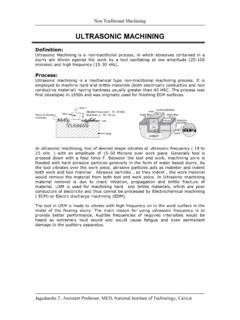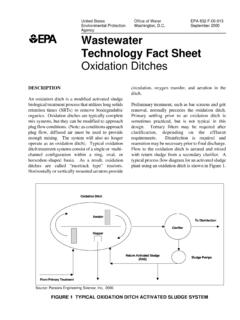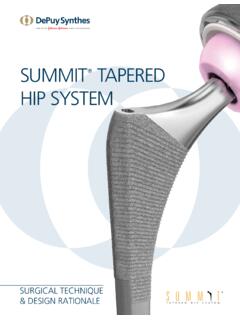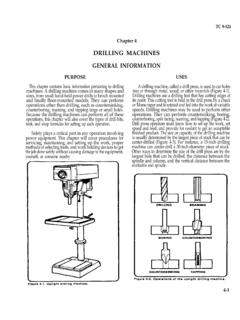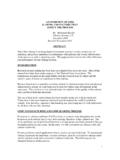Transcription of PARTICULATES NOT OTHERWISE REGULATED, RESPIRABLE 0600
1 NIOSH Manual of Analytical Methods (NMAM), Fourth EditionPARTICULATES NOT OTHERWISE REGULATED, RESPIRABLE 0600 DEFINITION:aerosol collected by sampler with CAS: None RTECS: None4- m median cut pointMETHOD: 0600, Issue 3 EVALUATION: FULLI ssue 1: 15 February 1984 Issue 3: 15 January 1998 OSHA :5 mg/m3 NIOSH:no RELACGIH: 3 mg/m3 PROPERTIES:contains no asbestos and quartz less than 1%;penetrates non-ciliated portions of respiratorysystemSYNONYMS:nuisance dusts; PARTICULATES not OTHERWISE classifiedSAMPLINGMEASUREMENTSAMPLER:CYC LONE + FILTER(10-mm nylon cyclone, Higgins-Dewell [HD]cyclone, or Aluminum cyclone + tared 5- mPVC membrane)FLOW RATE:nylon L/minHD L/minAl cyclone: L/minVOL-MIN:20 L @ 5 mg/m3 -MAX:400 LSHIPMENT:routineSAMPLESTABILITY:stableB LANKS:2 to 10 field blanks per setTECHNIQUE:GRAVIMETRIC (FILTER WEIGHT)ANALYTE:mass of RESPIRABLE dust mg sensitivity; use same balancebefore and after sample collectionCALIBRATION:National Institute of Standards andTechnology Class or ASTM Class 1 to 2 mg per sampleESTIMATED mg per samplePRECISION:<10 g with mg sensitivity balance.
2 <70 g with mg sensitivity balance [3]ACCURACYRANGE to 10 mg/m3 (lab and field)BIAS:dependent on dust size distribution [1]OVERALLPRECISION (rT):dependent on size distribution [1,2]ACCURACY:dependent on size distribution [1]APPLICABILITY: The working range is to 10 mg/m3 for a 200-L air sample. The method measures the mass concentration of anynon-volatile RESPIRABLE dust. In addition to inert dusts [4], the method has been recommended for RESPIRABLE coal dust. The method isbiased in light of the recently adopted international definition of RESPIRABLE dust, , +7% bias for non-diesel, coal mine dust [5].INTERFERENCES: Larger than RESPIRABLE particles (over 10 m) have been found in some cases by microscopic analysis of cyclonefilters. Over-sized particles in samples are known to be caused by inverting the cyclone assembly. Heavy dust loadings, fibers, and water-saturated dusts also interfere with the cyclone s size-selective properties.
3 The use of conductive samplers is recommended to minimizeparticle charge METHODS: This method is based on and replaces Sampling Data Sheet # [6]. PARTICULATES NOT OTHERWISE REGULATED: METHOD 0600, Issue 3, dated 15 January 1998 - Page 2 of 6 NIOSH Manual of Analytical Methods (NMAM), Fourth EditionSPECIAL PRECAUTIONS: : m pore size, polyvinyl chloride filter or equivalent hydrophobic membrane filtersupported by a cassette filter holder (preferably conductive). : 10-mm nylon(Mine Safety Appliance Co., Instrument Division, P. O. Box 427, Pittsburgh,PA 15230), Higgins-Dewell(BGI Inc., 58 Guinan St., Waltham, MA 02154)[7], aluminum cyclone(SKC Inc., 863 Valley View Road, Eighty Four, PA 15330), or sampling pump, L/min 5% for nylon cyclone, L/min 5% for HD cyclone, or L/min 5% for the Al cyclone with flexible connecting :Pulsation in the pump flow must be within 20% of the mean , analytical, with sensitivity of , NIST Class , or ASTM Class neutralizer, , Po-210; replace nine months after the production (preferably nylon).
4 Chamber or room for balance, , 20 C 1 C and 50% 5% OF SAMPLERS BEFORE the filters in an environmentally controlled weighing area or chamber for at least 2 the filters in an environmentally controlled area or chamber. Record the filter tare weight, W1(mg). the balance before each the filter with forceps (nylon forceps if further analyses will be done). the filter over an anti-static radiation source. Repeat this step if filter does not release easilyfrom the forceps or if filter attracts balance pan. Static electricity can cause erroneous the filters in the filter cassettes and close firmly so that leakage around the filter will not a plug in each opening of the filter cassette. the cyclone's grit cap before use and inspect the cyclone interior. If the inside is visibly scored,discard this cyclone since the dust separation characteristics of the cyclone may be altered.
5 Clean theinterior of the cyclone to prevent reentrainment of large the sampler head. Check alignment of filter holder and cyclone in the sampling head toprevent each personal sampling pump to the appropriate flow rate with a representative sampler in 1:Because of their inlet designs, nylon and aluminum cyclones are calibrated within a largevessel with inlet and outlet ports. The inlet is connected to a calibrator ( , a bubblemeter). The cyclone outlet is connected to the outlet port within the vessel, and the vesseloutlet is attached to the pump. See APPENDIX for alternate calibration procedure. (Thecalibrator can be connected directly to the HD cyclone.)NOTE 2:Even if the flowrate shifts by a known amount between calibration and use, the nominalflowrates are used for concentration calculation because of a self-correction feature of 45 min to 8 h. Do not exceed 2 mg dust loading on the filter.
6 Take 2 to 4 replicate samples foreach batch of field samples for quality assurance on the sampling procedure (see Step 10).NOTE :Do not allow the sampler assembly to be inverted at any time. Turning the cyclone toanything more than a horizontal orientation may deposit oversized material from the cyclonebody onto the PREPARATION: PARTICULATES NOT OTHERWISE REGULATED: METHOD 0600, Issue 3, dated 15 January 1998 - Page 3 of 6 NIOSH Manual of Analytical Methods (NMAM), Fourth EditionC(W2W1)(B2B1) , the top and bottom plugs from the filter cassette. Equilibrate for at least 2 h in anenvironmentally controlled area or AND QUALITY the microbalance before all weighings. Use the same microbalance for weighing filters before andafter sample collection. Calibrate the balance with National Institute of Standards and Technology or ASTM Class 1 set of replicate field samples should be exposed to the same dust environment, either in alaboratory dust chamber [8] or in the field [9].
7 The quality control samples must be taken with the sameequipment, procedures, and personnel used in the routine field samples. Calculate precision from thesereplicates and record relative standard deviation (Sr) on control charts. Take corrective action when theprecision is out of control [8]. each filter, including field blanks. Record this post-sampling weight, W2 (mg), beside itscorresponding tare weight. Record anything remarkable about a filter ( , visible particles, overloading,leakage, wet, torn, etc.). the concentration of RESPIRABLE particulate, C (mg/m3), in the air volume sampled, V (L):where: W1 = tare weight of filter before sampling (mg) W2 = post-sampling weight of sample-containing filter (mg) B1 = mean tare weight of blank filters (mg). B2 = mean post-sampling weight of blank filters (mg) V = volume as sampled at the nominal flowrate ( , L/min or L/min)EVALUATION OF : In RESPIRABLE dust measurements, the bias in a sample is calculated relative to the appropriaterespirable dust convention.
8 The theory for calculating bias was developed by Bartley and Breuer [10].For this method, the bias, therefore, depends on the international convention for RESPIRABLE dust, thecyclones' penetration curves, and the size distribution of the ambient dust. Based on measuredpenetration curves for non-pulsating flow [1], the bias in this method is shown in Figure dust size distributions in the shaded region, the bias in this method lies within the criterionestablished by NIOSH for method validation. Bias larger than would, therefore, be expected forsome workplace aerosols. However, bias within would be expected for dusts with geometricstandard deviations greater than , which is the case in most can also be caused in a cyclone by the pulsation of the personal sampling pump. Bartley, et al. [12]showed that cyclone samples with pulsating flow can have negative bias as large as relative tosamples with steady flow.
9 The magnitude of the bias depends on the amplitude of the pulsation at thecyclone aperture and the dust size distribution. For pumps with instantaneous flow rates within 20% ofthe mean, the pulsation bias magnitude is less than for most dust size distributions encounteredin the charges on the dust and the cyclone will also cause bias. Briant and Moss [13] have foundPARTICULATES NOT OTHERWISE REGULATED: METHOD 0600, Issue 3, dated 15 January 1998 - Page 4 of 6 NIOSH Manual of Analytical Methods (NMAM), Fourth Editionelectrostatic biases as large as -50%, and show that cyclones made with graphite-filled nylon eliminatethe problem. Use of conductive samplers and filter cassettes(Omega Specialty Instrument Co., 4 KidderRoad, Chelmsford, MA 01824) is recommended. : The figure mg quoted above for the precision is based on a study [3] of weighingprocedures employed in the past by the Mine Safety and Health Administration (MSHA) in which filtersare pre-weighed by the filter manufacturer and post-weighed by MSHA using balances readable to MSHA [14] has recently completed a study using a mg balance for the post-weighing,indicating imprecision equal to equal to mg was used for estimating the LOD and is based on specific suggestions[8] regarding filter weighing using a single mg balance.
10 This value is consistent with another study[15] of repeat filter weighings, although the actual attainable precision may depend strongly on thespecific environment to which the filters are exposed between the two : [1]Bartley DL, Chen CC, Song R, Fischbach TJ [1994]. RESPIRABLE aerosol sampler performance Ind. Hyg. Assoc. J., 55(11): 1036-1046. [2]Bowman JD, Bartley DL, Breuer GM, Shulman SA [1985]. The precision of coal mine dust , OH: National Institute for Occupational Safety and Health, DHEW (NIOSH) Pub. No. 85-220721. [3]Parobeck P, Tomb TF, Ku H, Cameron J [1981]. Measurement assurance program for the weighingsof RESPIRABLE coal mine dust samples. J Qual Tech 13:157. [4]ACGIH [1996]. 1996 Threshold limit values (TLVs ) for chemical substances and physical agents andbiological exposure indices (BEIs ). Cincinnati, OH: American Conference of Governmental IndustrialHygienists.










